
AMERICAN LEAGUE EAST
From Brooklyn to the Bronx you got the same story all winter: the Yanks can't miss. Hadn't they picked up 25-game winner Catfish Hunter, a bargain at $3 million? And wouldn't their other new sensation, Bobby Bonds, hit 65 home runs and steal 130 bases? The division would be wrapped up by Father's Day. Glory again.
Beneath this smog of Big Apple hyperbole was buried one pertinent fact: that team down in Baltimore had improved itself quite a bit, too. By spring training, reality had set in, and no one sensed it better than the objects of mythification themselves. "Baltimore has won the division five of the last six years," said Hunter. "You don't knock a winner." Added Bonds, "People keep talking about a second coming. From reading the Bible, I know there's only one Messiah, and I'm not him."
The Orioles have always traded well with the National League. Frank Robinson, Grant Jackson, Earl Williams, Mike Cuellar, Pat Dobson, Ross Grimsley and Tommy Davis came on over, and the next year there always seemed to be a title. Now Baltimore has acquired three National Leaguers, Rightfielder Ken Singleton (from Montreal), First Baseman Lee May (Houston) and Pitcher Mike Torrez (Montreal)—a No. 3 hitter, a No. 4 hitter and a fourth starter.
The switch-hitting Singleton has good power, and the fastball-hitting May could strike out more than 100 times, as is his wont, and still have 20 or more homers for the eighth straight year. "He's used to hitting in a big park," says Manager Earl Weaver. "We feel 20 homers are assured." Since Bobby Grich (19 homers, 82 RBIs) was the closest thing Baltimore had to a power hitter in 1974, May comes as a blessing.
Torrez completed a 15-8 year by winning his last six decisions, and at 28 he is four years younger than Dave McNally, the man the Orioles gave up to get him. He joins Cuellar, the 37-year-old Cuban wonder man, whose .665 win percentage over the last six years is the best in baseball; Grimsley (18-13); and the 1973 Cy Young Award winner, Jim Palmer. The uncertainty is Palmer, who won just seven games after injuring his elbow last spring. Bob Reynolds and Jackson, perhaps the best right-left relief combination in baseball, return in the bullpen.
Over the years one of the most decisive—and least appreciated—indexes of Oriole superiority has been defense. Golden Glovers Mark Belanger (shortstop), Brooks Robinson (third), Grich (second) and Paul Blair (center field) are back. Enough said. Elsewhere there is admirable depth at catcher (Andy Etchebarren, Dave Duncan, Elrod Hendricks, Williams) and in left field, where Al Bumbry, fresh from hitting .354 in Venezuela, and veteran Jim Northrup will spell Don Baylor. And lest we forget, Tommy Davis (.289) has been the best full-time DH in the game.
In realistic appraisals of the Yankees, a number of questions have been raised. Can Hunter repeat as a 25-game winner with a mediocre left-side defense (Third Baseman Graig Nettles, Shortstop Jim Mason, Leftfielder Lou Piniella), as well as a sore-armed catcher (Thurman Munson)? Can the Yankees count on Pitchers Rudy May, Larry Gura and Mike Wallace, who were 19 and 5, to do as well again? And can New York better its miserable 41-49 record in the East?
Of course, the Yankees did finish just two games out, and assuredly they have improved. The upswing began during the second half of last season, when they played .625 ball after acquiring Second Baseman Sandy Alomar. Moreover, how many teams have picked up a Hunter and a Bonds in a single winter? Most anyone would concede Catfish his fifth straight 20-win season, and the imagination soars at what Bonds (186 homers, 552 RBIs, 263 stolen bases in seven seasons) might accomplish. Says Baltimore's Palmer, "The fact that he's a bad breaking-ball hitter and still has a lifetime average of .276 shows what kind of ballplayer he is." Given the green light by Manager Bill Virdon, Bonds could help the Yankees double their total of 53 stolen bases, worst in the league, and after windy Candlestick the fences in Shea Stadium are going to seem awfully accessible
Bonds joins a good-hitting team. Elliott Maddox hit .303 and finished eighth in the Most Valuable Player balloting. Ron Blomberg, Alex Johnson and Roy White are capable DHs, Nettles and Munson have power, and Piniella has a .288 lifetime average. Nineteen-game winners Pat Dobson and George (Doc) Medich are sure to make the rotation, and Rudy May will join them if he maintains his end-of-season form. As usual, the Yankees' last line of defense is irrepressible and indispensable Reliever Sparky Lyle.
And what are we to make of those baffling boys from Boston, the pride and despair of New England, the only team with a press book that knocks its own players? In their favor, the Bosox did not immediately relinquish their lead as expected after Carlton Fisk was lost for the season with torn knee cartilage last June 28. But when Boston gave Luis Tiant 11 hits in four starts and ultimately lost eight straight, Fisk's bat was sorely missed. Fisk was jolted anew on March 12 when he was hit by a pitched ball and suffered a broken right arm. He will not be back in action until mid-June.
The Red Sox also are concerned about Pitcher Rick Wise (shoulder) and Second baseman Doug Griffin (back). Overweight last year, when he had a 12-14 record, a trimmer Reggie Cleveland can expect to do quite a bit better. Tiant (22-13) and Bill Lee (17-15) cannot go it alone again. Indeed, with an undermanned bullpen, Boston probably will have to increase its league lead in complete games (71) to be a contender.
It would gladden all New England if Tony Conigliaro could make a comeback after 3½ years away from the game with eye troubles. The onetime heartthrob and rock star turned 30 the day before Elvis turned 40. Tony came to camp, got a hit in his first game—and pulled a hamstring. A sound Conigliaro would help, since 31-year-old Rico Petrocelli (15 homers, 76 RBIs) and 35-year-old Carl Yastrzemski (.301, 15 homers, 79 RBIs, 104 walks) might pick this year to begin slowing down. Much is expected of such youngsters as Rightfielder Dewey Evans (.281), Shortstop Rick Burleson (.284), Centerfielder Rick Miller, and neophyte outfielders Fred Lynn and Jim Rice. But all in all, an iffy team.
Cleveland led the division on July 5, was in contention until September and drew one million fans for the first time since 1959, but was far too dependent on the pitching of Gaylord and Jim Perry, who accounted for 38 of the club's 77 wins. Now Manager Frank Robinson has mandated that Fritz Peterson win 15 to 20 games.
Peterson reported slimmed down, for a change. Another heavy problem, Boog Powell, checked in from Baltimore to play first. It would be nice if he could manage to hit better than his weight (250) although Cleveland has adequate power in John Ellis, Oscar Gamble, Charlie Spikes, George Hendrick and Robinson. What the ponderous Indians, who were last in the league in sacrifice flies and walks, really lack are speed and smarts from players other than Outfielder John Lowenstein (36 stolen bases).
Henry Aaron's return to Milwaukee is more than good public relations. The Brewers need his bat. Though Pedro Garcia, Don Money, George Scott, Darrell Porter and John Briggs collectively hit 73 homers, the club was last in batting (.244), ninth in RBIs, 10th in walks and first in strikeouts. Manager Del Crandall hopes Aaron can hit 25 to 30 homers and 90 RBIs. "If I bat 200 times more [he was up 340 times in 1974], there's no telling what I'll do," Aaron says.
Brewer bats will have to be fearsome to compensate for a pitching staff whose biggest winner, Jim Slaton, had a 13-16 record. "I've always walked too many people," Slaton says, "but this winter in the Dominican Republic I walked something like 15 in 100 innings." His improvement, if maintained, would be helpful in June and July, months in which he won a total of two games in 1974. The brightest surprise of the summer was Bill Champion (11-4). Two other starters, Jim Colborn and Ed Sprague, have had knee operations. The defense, led by Third Baseman Money's .989 fielding percentage, the best ever at that position, is right up there with Baltimore's.
Detroit's problems start with its No. 1 pitcher. "I had torn cartilage in my knee the last six weeks of the season," says Mickey Lolich. "My record went from 16-14 to 16-21. They drained the knee and injected dye to see what was wrong. Every time I went in to see the doctor it felt better. He decided it wouldn't help to operate. I'm just keeping my fingers and toes crossed. I hope I don't step into a hole." If he doesn't, Lolich, who has 2,540 strikeouts, should pass Bob Feller and Warren Spahn to become fifth on the alltime list. No. 2 starter Joe Coleman is trying to rebound from a disappointing 14-12 record. Lerrin LaGrow (8-19) began the exhibition season by giving up 14 earned runs in 3‚Öì innings for an ERA of slightly under 38.00, which opens the doors for young pitchers with names like Ruhle, Lemanczyk and Holdsworth. You probably haven't heard of them, but then Pitching Coach Steve Hamilton hasn't, either. As things are, Reliever John Hiller could pitch more often than Mike Marshall.
Attendance plummeted 500,000 in 1974, and with Al Kaline and Norm Cash gone, it could drop some more. The best attractions are Lolich, Willie Horton, Nate Colbert, the power-hitting newcomer, and Centerfielder Ron LeFlore, whose speed and potential are the talk of the division. The spirit, at least, is entirely willing.
ILLUSTRATION

